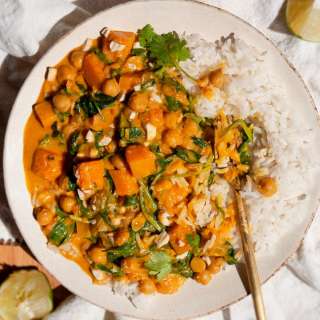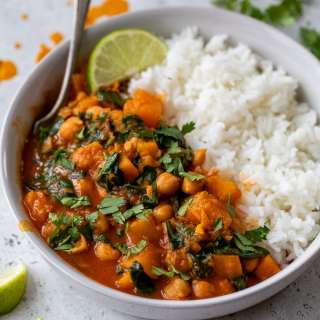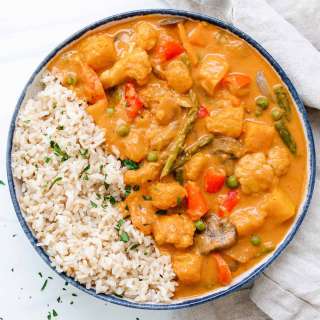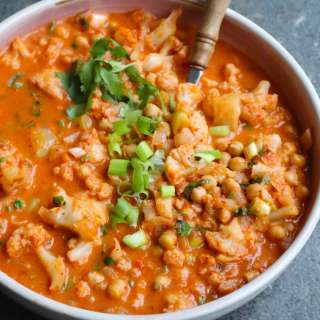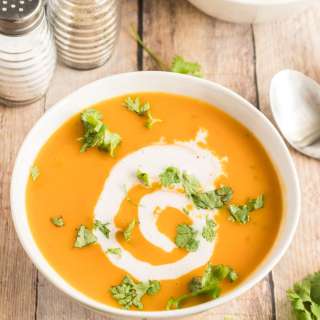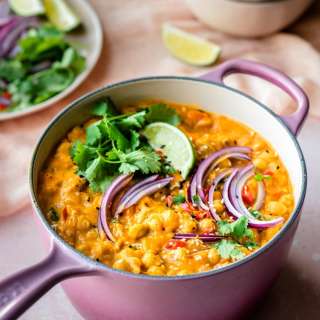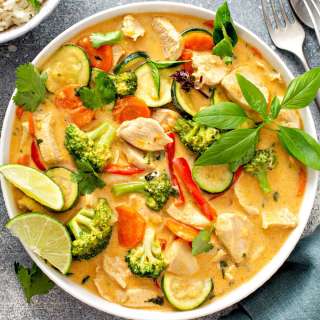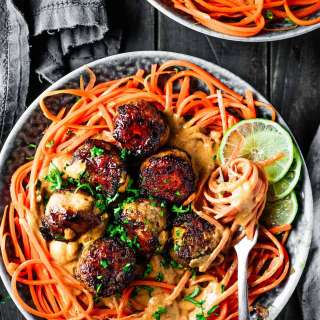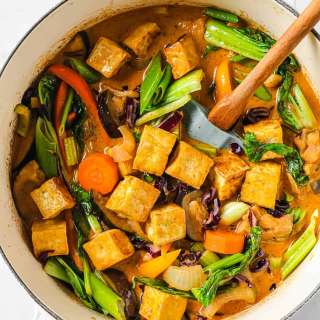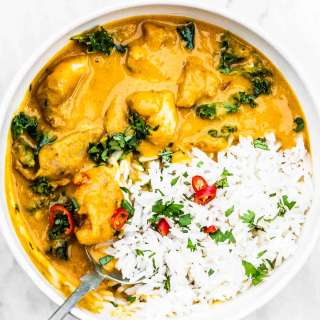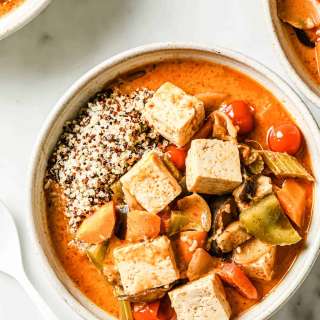
Butternut Squash Curry with Chickpeas
User Reviews
5.0
777 reviews
Excellent

Butternut Squash Curry with Chickpeas
Report
A simple and flavorful recipe that's sure to be a favorite.
Share:
Ingredients
- 1 1/2 tablespoons unrefined coconut oil (use refined for a neutral taste, or a neutral oil of choice)
- 1 large onion, diced
- 2 medium carrots, diced
- Kosher salt to taste
- 4 cloves garlic, minced
- 2- inch piece ginger, grated or finely minced*
- 1-3 bird's eye chili peppers, thinly sliced (optional; only use for spicy!)**
- 2 talks fresh lemongrass, minced or grated (optional but recommended)***
- 5 tablespoons red curry paste (see Notes below on spiciness level and brands)****
- 1 (13.5-ounce) (400 mL) can full-fat coconut milk
- 1 cup (240 mL) low-sodium vegetable broth (or water)
- 5 cups (700-730g) of peeled and cubed butternut squash (~ 2.5 pound butternut squash)
- 2 1/2 tablespoons reduced-sodium soy sauce (or 1 tablespoon Thai Light Soy Sauce)*****
- 1 1/2 tablespoons coconut sugar (or pure maple syrup)
- 2 ounce (425g) cans of chickpeas, rinsed and drained
- 4 cups (60g) baby spinach or baby kale (about 4 large handfuls)
- 1 tablespoon lime juice or rice vinegar
- 1 large handful fresh cilantro, roughly chopped
- 1 handful Thai basil leaves
- white rice or brown rice (for serving, optional)
Instructions
- Heat a Dutch oven or a large saucepan over medium-high heat. Add the coconut oil, and once shimmering, add the onions and carrots along with a pinch of kosher salt. Cook the vegetables for 7-8 minutes, or until they are tender and lightly browned.
- Add the garlic, ginger, chili peppers (if using), lemongrass (if using), and red curry paste, and cook for 2 minutes, stirring frequently to coat the vegetables & prevent burning. If not using a nonstick pan, you'll likely need to add a tablespoon or two of water to prevent the mixture from drying out, sticking, and burning.
- Pour in a couple spoons of the coconut milk and allow it to bubble for a minute, stirring well. Add the vegetable broth, stirring with a spatula to scrape up any browned bits stuck to the bottom of the pot. Pour in the remaining coconut milk, cubed squash, soy sauce, and coconut sugar, stirring to combine.
- Bring the mixture to a boil, then reduce the heat to low or medium-low to maintain a rapid simmer for 20 minutes, or until the squash is tender and cooked through. Turn off the heat and use an immersion blender to blend roughly half of the curry. Make sure to leave some chunks of squash intact. Alternatively, transfer half of the curry to a stand blender. Blend until the mixture is puréed and mostly smooth, then return it to the pan and stir to combine.
- Stir in the chickpeas and bring the curry to a gentle simmer. Once simmering, stir in the baby spinach or kale, stirring until the greens have wilted.
- Turn off the heat, and stir in the lime juice or rice vinegar. Taste for seasonings, adding salt as needed. Tear the Thai basil leaves to release their oils; add them to the curry, along with the chopped cilantro.
- Serve the curry over rice. Garnish with additional cilantro or Thai basil as desired.
Notes
- * Traditionally, galangal is used instead of ginger in Thai curries. If you have access to galangal, feel free to use that instead of ginger.
- ** Use bird's eye chili peppers only if you like spicy food. My personal preference is to use 3 of them, but I like my food spicier than most of my readers. For most, start with 1 pepper. If not available, use 1 serrano pepper.
- *** You need to peel several layers of lemongrass, then use only the tender, inner white bulb at the bottom. For tips on how to peel/cut lemongrass, watch the Youtube video starting at the 3:09 mark.
- the tender, inner white bulb at the bottom. For tips on how to peel/cut lemongrass, watch the Youtube video starting at the 3:09 mark.
- **** There is variability in spiciness across curry paste brands. The best Thai curry paste that's vegan is Maesri, which is spicier than, say, the Thai Kitchen, brand. For a spicy version, I use 5 tbsp Thai Kitchen paste.
- ***** Thai Soy Sauce, aka Thin Soy Sauce or Light Soy Sauce, can be found at Southeast Asian grocery stores. It is much saltier than a standard grocery store soy sauce (e.g., Kikkoman). If using the latter, use 1 1/2 to 2 tablespoons. If using reduced-sodium soy sauce, use 2 1/2 tablespoons. To keep this recipe gluten-free, use tamari.
Nutrition Information
Show Details
Calories
400kcal
(20%)
Carbohydrates
48g
(16%)
Protein
12g
(24%)
Fat
21g
(32%)
Saturated Fat
16g
(80%)
Polyunsaturated Fat
2g
Monounsaturated Fat
2g
Sodium
880mg
(37%)
Potassium
1079mg
(31%)
Fiber
11g
(44%)
Sugar
8g
(16%)
Vitamin A
19817IU
(396%)
Vitamin C
55mg
(61%)
Calcium
179mg
(18%)
Iron
6mg
(33%)
Nutrition Facts
Serving: 6with rice
Amount Per Serving
Calories 400 kcal
% Daily Value*
| Calories | 400kcal | 20% |
| Carbohydrates | 48g | 16% |
| Protein | 12g | 24% |
| Fat | 21g | 32% |
| Saturated Fat | 16g | 80% |
| Polyunsaturated Fat | 2g | 12% |
| Monounsaturated Fat | 2g | 10% |
| Sodium | 880mg | 37% |
| Potassium | 1079mg | 23% |
| Fiber | 11g | 44% |
| Sugar | 8g | 16% |
| Vitamin A | 19817IU | 396% |
| Vitamin C | 55mg | 61% |
| Calcium | 179mg | 18% |
| Iron | 6mg | 33% |
* Percent Daily Values are based on a 2,000 calorie diet.
Genuine Reviews
User Reviews
Overall Rating
5.0
777 reviews
Excellent
Other Recipes
